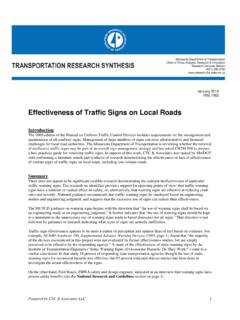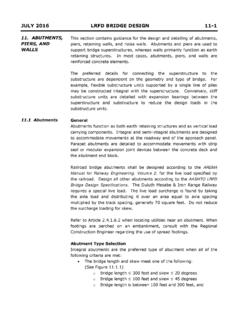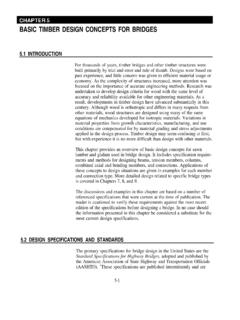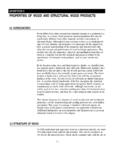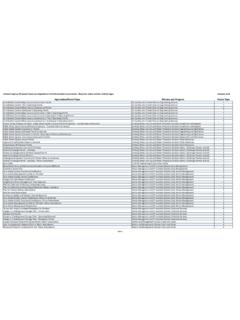Transcription of MINNESOTA DEPARTMENT OF TRANSPORTATION …
1 MINNESOTA DEPARTMENT OF TRANSPORTATION . engineering services division Technical Memorandum No. 11-12-B-04. May 24, 2011. To: Electronic Distribution Recipients From: Jon M. Chiglo, division Director, engineering services Subject: Critical Deficiencies found during bridge inspections Expiration This new Technical Memorandum supersedes TM-08-02-B-02 and it will expire May 24, 2016 unless superseded prior to this date. Implementation This policy and its instructions are effective immediately for state and local bridges. Introduction This Technical Memorandum establishes a formal procedure for responding, reporting, and documenting Critical Deficiencies found during scheduled bridge inspections. Purpose The Federal Highway Administration requires that all states develop a process to monitor critical deficiencies found during bridge inspections.
2 This Technical Memorandum is intended to provide the necessary guidelines to fulfill the FHWA requirements. The guidelines described in this document are based on the Critical Deficiency Procedures as outlined in Section of the AASHTO Manual for Condition Evaluation of Bridges which states : Critical structural and safety-related deficiencies found during the field inspection and/or evaluation of a bridge should be brought to the attention of the bridge Owner or responsible agency immediately if a safety hazard is present. Standard procedures for addressing such deficiencies should be implemented, including: Immediate critical deficiency reporting steps, Emergency notification to police and the public, Rapid evaluation of the deficiencies found, Rapid implementation of corrective of protective actions, A tracking system to ensure adequate follow-up actions, or Provisions for identifying other bridges with similar structural details for follow-up inspections.
3 It is recognized nationally that some past bridge failures may have been prevented if prompt attention had been given to concerns noted on bridge inspection reports. To ensure public safety, it is essential that Critical Deficiencies not only be brought to the attention of those responsible but that these findings are reviewed to confirm that all necessary corrective actions have been completed. -MORE- Technical Memorandum No. 11-12-B-04. Critical Deficiencies found during bridge inspections May 24, 2011. Page 2. Guidelines For the purpose of this Technical Memorandum, the following definitions shall apply. Critical Deficiency: A Critical Deficiency is defined as any condition discovered during a scheduled bridge inspection that threatens public safety and, if not promptly corrected, could result in collapse or partial collapse of a bridge .
4 Critical findings include structural conditions and scour or hydraulic conditions that are found to be critical during the inspection or that are likely to become critical to the stability of the bridge before the next regularly scheduled inspection. Hazardous Deficiency: A Hazardous Deficiency is defined as an element level condition found during a regularly scheduled bridge inspection that may be hazardous to public safety, but IS NOT expected to lead to collapse or partial collapse of the bridge . While any Hazardous Deficiency found during a bridge inspection should immediately be reported to the bridge owner (or appropriate authority), the Mn/DOT bridge Office requires no subsequent documentation. bridge : A bridge is defined as any bridge , culvert, tunnel, or other structure listed on the Mn/DOT bridge Inventory.
5 bridge Inspection: A bridge inspection includes any routine inspection, special inspection, hands-on Fracture Critical inspection, or underwater inspection performed on a bridge . bridge Inspector: A bridge Inspector is defined as the inspection team leader which is a certified Level 2, Level N, or Level E inspector this includes inspectors employed by Mn/DOT, Counties, Cities, or by private consultants. engineer : The engineer is defined as the supervising registered Professional engineer of the entity listed on the Mn/DOT bridge Inventory as having report jurisdiction for the bridge . In most cases, this will be the Mn/DOT District bridge engineer , the County engineer , or the City engineer . bridge Owner: The bridge Owner is defined as the entity listed on the Mn/DOT bridge Inventory as the Owner of the bridge .
6 Mn/DOT bridge Inspections engineer : The Mn/DOT bridge Inspection engineer . refers to the State bridge Inspection engineer who is the primary statewide contact for reporting Critical bridge Deficiencies. Mn/DOT bridge Inspection engineer 3485 Hadley Ave North Oakdale, MN 55128. (651) 366-4567. Critical Deficiency Process: The following guidelines outline and describe the procedures to be followed if a Critical Deficiency is observed during a bridge inspection. These guidelines are divided into three parts, Responsibilities of the bridge Inspector, Responsibilities of the engineer with Reporting Jurisdiction, and Responsibilities of the Mn/DOT bridge Inspection engineer . -MORE- Technical Memorandum No. 11-12-B-04. Critical Deficiencies found during bridge inspections May 24, 2011. Page 3. Part 1 Responsibilities of the bridge Inspector: Upon discovery of a Critical Finding ; the bridge Inspector is responsible for the following: 1) Emergency bridge Closure: If the observed condition is severe enough to warrant immediate closure of the bridge (or immediate restriction of traffic above or below the bridge ), the bridge Inspector shall immediately take any actions necessary to ensure public safety.
7 2) Prompt Notification of the engineer : Upon discovery of a Critical Deficiency, the bridge Inspector shall promptly notify the engineer . The inspector should identify the bridge number, bridge location, and clearly and accurately describe the critical condition. 3) Inspection Report: In addition to the prompt verbal notification, the following written documentation must be completed: a) If the Critical Deficiency is observed during a routine (NBI/SIMS). inspection, the inspector should rate the Critical Finding Smart Flag (Element #964) as Condition State 2 , and briefly describe the critical finding (if necessary, supplemental notes, sketches, photos, and measurements should be included to fully describe the situation) and submit the inspection to the engineer . b) If the Critical Deficiency is observed during a hands-on Fracture Critical inspection, underwater inspection, or other special inspection, the inspector must submit a brief written statement or report describing the condition (as described in step 2 above) to the engineer within 48 hours after finding the Critical Deficiency.
8 Part 2 Responsibilities of the engineer : Upon being notified of a Critical Deficiency, the engineer is responsible for the following .. 1) Rapid Evaluation: The engineer is required to quickly assess the situation to confirm or refute the finding, and to initiate necessary traffic restrictions to safeguard the public. If in doubt, the engineer should temporarily close or restrict traffic on the bridge , then contact a consulting bridge engineer , the Mn/DOT bridge Inspection engineer , or the Mn/DOT bridge Office (651) 366-4500 for assistance. If the engineer determines that the condition reported is not a Critical Deficiency, the Critical Finding Smart Flag (Element #964) can be changed back to Condition State 1 after discussing with the inspector (the Mn/DOT bridge Office requires no subsequent documentation).
9 2) Traffic Control & Public Notification: The engineer shall be responsible for coordinating all necessary traffic control (such as load restrictions, lane or bridge closures, or detours). The engineer shall also be responsible for the public notification of any traffic restrictions. 3) Immediate Notification of the bridge Owner: If the bridge owner (as listed on the Mn/DOT inventory) is different than the entity with report jurisdiction , the engineer shall be responsible for informing the bridge Owner that a Critical Deficiency has been found. -MORE- Technical Memorandum No. 11-12-B-04. Critical Deficiencies found during bridge inspections May 24, 2011. Page 4. 4) Submittal of Inspection Report to the Mn/DOT bridge Inspection engineer : Within 7 days after a Critical Deficiency has been reported, the engineer must notify Mn/DOT's bridge Inspections engineer of the finding and must submit a copy of the inspection report.
10 5) Rapid Implementation of Corrective Action: The engineer is responsible for promptly scheduling repairs to the bridge . If the bridge remains open to traffic, the engineer is responsible for determining the proper load rating for the bridge , and ensuring that the rating is adequately posted. 6) Resolution of Deficient Status: After repairs have been completed, the engineer should change the Critical Finding Smart Flag (Element #964). rating to Condition State 1 , and add a brief description of the corrective actions taken in the inspection notes for that smart flag. A copy of the revised inspection report must then be submitted to the Mn/DOT bridge Inspection engineer . 7) Updating of the bridge Inventory: If the bridge load rating is permanently reduced, the engineer must submit a new load rating to the Mn/DOT bridge Inspection engineer .

